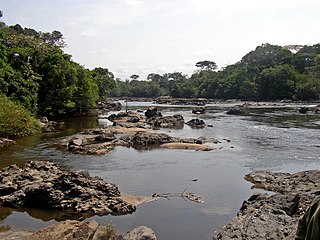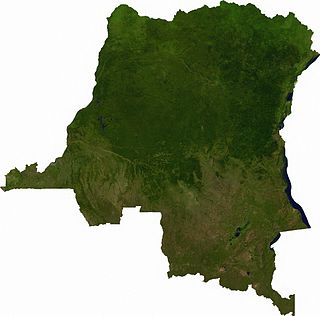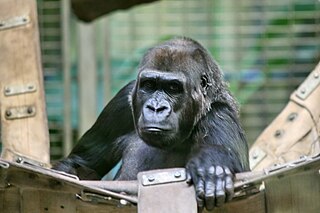
The African forest elephant is one of the two living species of African elephant. It is native to humid tropical forests in West Africa and the Congo Basin. It is the smallest of the three living elephant species, reaching a shoulder height of 2.4 m. As with other African elephants, both sexes have straight, down-pointing tusks, which begin to grow once the animals reach 1–3 years old. The forest elephant lives in highly sociable family groups of up to 20 individuals. Since they forage primarily on leaves, seeds, fruit, and tree bark, they have often been referred to as the 'megagardener of the forest'; the species is one of many that contributes significantly to maintaining the composition, diversity and structure of the Guinean Forests of West Africa and the Congolese rainforests. Seeds of various plants will go through the elephant's digestive tract and eventually pass through in the animal's droppings, thus helping to maintain the spread and biodiversity of the forests.

The Lord's Resistance Army insurgency is a conflict involving the Lord's Resistance Army against the government of Uganda. Following the Ugandan Civil War, militant Joseph Kony formed the Lord's Resistance Army and launched an insurgency against the newly installed President Yoweri Museveni. The stated goal was to establish a Christian state based on the Ten Commandments. Currently, there is low-level LRA activity in eastern Democratic Republic of the Congo and the Central African Republic. Kony proclaims himself the 'spokesperson' of God and a spirit medium.

The Okapi Wildlife Reserve is a wildlife reserve in the Ituri Forest in the north-east of the Democratic Republic of the Congo, near the borders with South Sudan and Uganda. At approximately 14,000 km2, it covers approximately one-fifth of the area of the forest. In 1996, the Okapi Wildlife Reserve was designated a UNESCO World Heritage Site, due to its large population of endangered okapis and its high overall biodiversity.

Garamba National Park is a national park in the north-eastern Democratic Republic of the Congo covering nearly 5,200 km2 (2,000 sq mi). It is among Africa's oldest parks and was designated a World Heritage Site by UNESCO in 1980 for its protection of critical habitat for northern white rhinoceroses, African elephants, hippopotamuses, and giraffes. Garamba National Park has been managed by African Parks in partnership with the Institut Congolais pour la Conservation de la Nature since 2005.
Maiko National Park is a national park in the Democratic Republic of the Congo. It lies in one of the most remote forest areas of the country and covers 10,885 km2 (4,203 sq mi). The park is divided into three sectors, straddling the states of Nord Kivu, Province Orientale and Maniema. Three of the country's spectacular endemic animals occur here: the Grauer's gorilla, the okapi, and the Congo peafowl. Maiko is also an important site for the conservation of the African forest elephant, eastern chimpanzee and the endemic aquatic genet.

Salonga National Park is a national park in the Democratic Republic of the Congo located in the Congo River basin. It is Africa's largest tropical rainforest reserve covering about 36,000 km2 or 3,600,000 hectares. It extends into the provinces of Mai Ndombe, Equateur, Kasaï and Sankuru. In 1984, the national park was inscribed on the UNESCO World Heritage List for its protection of a large swath of relatively intact rainforest and its important habitat for many rare species. In 1999, the site has been listed as endangered due to poaching and housing construction. Following the improvement in its state of conservation, the site was removed from the endangered list in 2021.

Articles related to the Democratic Republic of the Congo include:
Odzala-Kokoua National Park is a national park in the Republic of the Congo. The park was first protected in 1935, declared a biosphere reserve in 1977, and granted official designation by presidential decree in 2001. Odzala-Kokoua has approximately 100 mammals species, and one of the continent's most diverse primate populations. The nonprofit conservation organization African Parks began managing the park in collaboration with the Ministry of Forest Economy, Sustainable Development and Environment of the Republic of the Congo in 2010.

The Lord's Resistance Army (LRA) is a Christian extremist organization operating in Central Africa and East Africa. Its origins were in the Ugandan insurgency (1986–1994) against President Yoweri Museveni during which Joseph Rao Kony founded the LRA in 1987.
The 2008–2009 Garamba offensive started on 14 December 2008, when joint Ugandan, DR Congolese and Southern Sudanese forces launched a botched military attack against the Lord's Resistance Army (LRA) in the Garamba region of DR Congo.

African Parks is a non-governmental organization (NGO) focused on biodiversity conservation through protected area management, established in 2000 and headquartered in Johannesburg, South Africa. It was founded as the African Parks Management and Finance Company, a private company, then underwent structural changes to become an NGO called African Parks Foundation, and later renamed African Parks Network. The organization manages national parks and protected areas throughout Africa, in collaboration with governments and surrounding communities. African Parks manages 22 protected areas in 12 countries as of May 2023, and employs more than 5000 staff. Michael Eustace, Peter Fearnhead, Paul Fentener van Vlissingen, Anthony Hall-Martin, and Mavuso Msimang are credited as co-founders; Fearnhead continues to serve as chief executive officer. Prince Harry served as African Parks' president between 2017 and 2023 and later became a member of the board of directors.

The wildlife of the Central African Republic is in the vast natural habitat in the Central African Republic (CAR) located between the Congo Basin's rain forests and large savannas, where the human density was smaller than 0.5 per km2 prior to 1850. The forest area of 22.755 million, considered one of the richest storehouses of wildlife spread over national parks, hunting reserves and community hunting areas, experienced an alarming loss of wildlife because of greed for ivory and bushmeat exploitation by hunters – mostly Arab slavers from across the borders of the Central African Republic with Chad and Sudan.

The geography of South Sudan describes the physical features of South Sudan, a country in East Africa. South Sudan is a landlocked country and borders – clockwise – Sudan from the north, Ethiopia from the east, Kenya, Uganda and the Democratic Republic of the Congo from the south and the Central African Republic from the west.

Damien Mander is an anti-poaching activist and the founder of Akashinga. He is a former Australian Royal Navy Clearance Diver and Special Operations military sniper. He is also a director of the Conservation Guardians. In 2019 he received the Winsome Constance Kindness Trust Gold Medal.
The Nutrecul Agroforestry Project is a project which promotes the use of the indigenous multipurpose tree species Treculia africana. This project was initiated by Belgian agronomists and missionaries in the rainforest of the Democratic Republic of the Congo; and later entrusted to Congolese-Belgian philanthropist and horticulturist Jean Kiala-Inkisi. The project promotes Forestry combined with alternative food provision through agro-forestry techniques.
The Regional Cooperation Initiative for the elimination of the LRA (RCI-LRA) with its military arm, the African Union Regional Task Force was a multi-national operation to counter the Lord's Resistance Army (LRA). On 22 November 2011 the AU Peace and Security Council authorized the RCI-LRA with the mandate to "strengthen the operational capabilities of the countries affected by the atrocities of the LRA, create an environment conducive to the stabilization of the affected areas, free of LRA atrocities, and facilitate the delivery of humanitarian aid to affected areas." The United Nations provided logistical support, the European Union and African Union contributed additional funding, and the United States provided non-combat military and strategic support.
Wildlife Angel is a wildlife protection non-governmental organization (NGO) based in Strasbourg (France). Its three main objectives are to protect wildlife, to protect rangers and to fight poaching by intervening in national parks, private reserves and working with other non-governmental organizations (NGO). Wildlife Angel intervenes directly in the field with rangers in charge of animal protection.
Environmental issues in the Democratic Republic of the Congo are the consequence of compounding social and economic problems, including lack of access to clean energy, clearing of lands for agriculture and economic development, and armed conflict. Major environmental issues in DRC include deforestation, poaching, which threatens wildlife populations, water pollution and mining.
Chinko, also known as Chinko Nature Reserve and the Chinko Project Area, is a protected area in the Central African Republic. The nonprofit conservation organization African Parks began managing Chinko in partnership with the government of the Central African Republic in December 2014.

Fortress conservation is a conservation model based on the belief that biodiversity protection is best achieved by creating protected areas where ecosystems can function in isolation from human disturbance. Its implementation has been criticized for human rights abuses against indigenous inhabitants when creating and maintaining protected areas.











